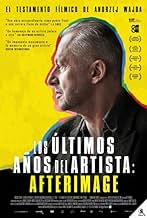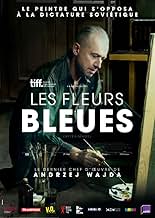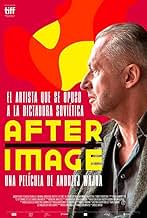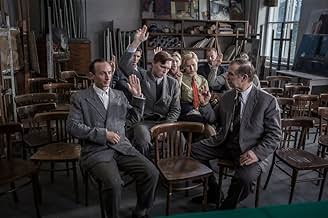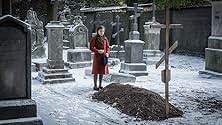La storia del pittore carismatico Wladyslaw Strzeminski, che si oppose al realismo sociale e mantenne la propria libertà artistica nonostante gli ostacoli politici.La storia del pittore carismatico Wladyslaw Strzeminski, che si oppose al realismo sociale e mantenne la propria libertà artistica nonostante gli ostacoli politici.La storia del pittore carismatico Wladyslaw Strzeminski, che si oppose al realismo sociale e mantenne la propria libertà artistica nonostante gli ostacoli politici.
- Regia
- Sceneggiatura
- Star
- Premi
- 2 vittorie e 12 candidature totali
Recensioni in evidenza
The film scenes are precise and the transitions between them are remarkably fluid, scary good! The acting is exemplary. The actors are cast perfectly, especially the main actor and the young woman who portrays his long-suffering daughter. Such wonders are the marks of a masterful director. Wajda died just after the completion of the film. Wajda was the trusting sort, said a friend of his, just before the film began. Such trust in his crew paid dividends. Seen at the Miami International Film Festival.
In the very first scene, we see Strzeminski in a beautiful green meadow, teaching his pupils how to paint a landscape. When a new pupil presents herself, he literally rolls down the hillside to meet her - in spite of his disabilities: he misses one leg and one arm. Strzeminski is happy and upbeat. During the film, this proud man slowly transforms into a human wreck. At the end, he is no longer able to stand on his feet, let alone roll down a hillside.
Bit by bit, the communists make his life impossible. In a visually stunning scene, all light in his apartment turns red, because of a giant Stalin banner which is attached over his window. Furious, because he is no longer able to paint in natural daylight, he tears the banner with one of his crutches. It's the start of a fight against the system that turns out to be futile.
Director Andrzej Wajda, who died last year, shows Strzeminski as a man who lives for his art, and for nothing else. Even his teenage daughter is forced to move to an orphanage, because he doesn't seems to be interested in raising her. Wajda shows Strzeminski's weaknesses, but also his opponent's doubts. Many of them somehow sympathize with him, but are unable to show support without risking their own position. An example is the manager of the local museum, who cannot display his paintings, but carefully keeps them in storage.
Parallel with Strzeminski's decline, we witness also Poland's transformation from a proud nation into a Soviet-dominated satellite state, where communist propaganda is everywhere and the quality of life deteriorates rapidly. In one scene, Strzeminski is turned down by a shop selling painting materials, because his membership of the artist's union is withdrawn. He hides his disappointment and takes his daughter to the cinema. But there he finds out he has to watch Soviet propaganda. Disgusted, he leaves the theatre.
'After Image' shows an important episode of Poland's artistic history. At the same time, it is a warning against any totalitarianism, and an ode to artistic freedom.
The last movie of Andrzej Wajda tells the story of one of the best artists of the 20th Century, Wladyslaw Strzeminski.
The movie states that the situation of a true artist is miserable in spite of the geography, language and culture. Wladyslaw Strzeminski is a great painter, and is suffering due to his personal views, during a great social reformation in Poland. He loose his job, artist license canceled, and ignored in every corner of life. Though his students try to support him, it doesn't make much use. Hungry and sick, a great artist faces the tough realities of life.
The performance of the cast are amazing. Boguslaw Linda as Strzeminski and all the remaining cast have done a wonderful job. Photography and direction is so superb.
I noticed the audience after the movie, they had tears in their eyes. It is so heart touching. Do not miss this movie, if you are a real movie freak!
There is one major difference though. Many of his previous films focused on political characters, they were about men who changed history, about victors at least at the historical scale - Danton, Walesa - even if they sometime paid with their lives. The hero of this film, the avant-garde Polish artist Wladyslaw Strzeminski was defeated by history, and the film is the story of his defeat, of his physical but also moral decay. It's a story quite typical about the manner Communist dictatorships in Eastern Europe treated their artists, and even if I did not know anything about him before this movie, his story was well known to me as the same fate (or worse in some cases) was imposed on artists who did not compromise in Romania where I was born and I lived half of my life. We see him at the beginning admired and valued as a teacher and artist, he also was a companion of modernist artists who were associated with the Russian revolution, but this did not help him either. He was not an anti-Communist, but he valued true art, could not accept enrollment of art as a tool for propaganda and the norms of the dogmatic 'realism', and his refusal to compromise cost him his teaching position, his membership in the artist's union, the very possibility of painting. The humiliating tentative to find a way to survive had no chance, the regime was still in the Stalinist period and crushed all opponents according to the principle 'the one who is not with us is against us'. Even the help and support of a handful of students who stood by their beloved teacher and mentor could not save him.
The lead role is played with a lot of restraint and dignity by Boguslaw Linda, his flame is interior, he shows the artist far from being a flawless person, actually sharing some of the guilt of not being able to maintain his family and especially help his teen daughter (exceptional acting of 14 years old Bronislawa Zamachowska). There are many very well constructed scenes, some of them full with details bringing back to life with controlled anger that dark period of transformation, when Poland and Eastern Europe were postponing hope for a few decades and were transitioning from one nightmare to another. Wajda's last film is not a testament, it's an integral part of his opus of work.
Lo sapevi?
- QuizOfficial submission of Poland for the 'Best Foreign Language Film' category of the 89th Academy Awards in 2017.
- Citazioni
Wladyslaw Strzeminski: They praise the ones who suck up. They're silent about the real artists.
Julian Przybos: I spoke about this with Milosz. He also believes that an artist who can't speak with a full voice should be silent. Artists can be killed in two ways: either by talking about them too much or not at all.
- ConnessioniReferences L'uomo di marmo (1977)
- Colonne sonoreLandscape
Written by Andrzej Panufnik
Performed by Narodowa Orkiestra Symfoniczna Polskiego Radia w Katowicach
Conducted by Piotr Komorowski
I più visti
- How long is Afterimage?Powered by Alexa
Dettagli
- Data di uscita
- Paese di origine
- Siti ufficiali
- Lingua
- Celebre anche come
- Afterimage
- Luoghi delle riprese
- Aziende produttrici
- Vedi altri crediti dell’azienda su IMDbPro
Botteghino
- Lordo Stati Uniti e Canada
- 33.443 USD
- Fine settimana di apertura Stati Uniti e Canada
- 5832 USD
- 21 mag 2017
- Lordo in tutto il mondo
- 1.032.768 USD
- Tempo di esecuzione
- 1h 38min(98 min)
- Colore
- Mix di suoni
- Proporzioni
- 2.35 : 1




